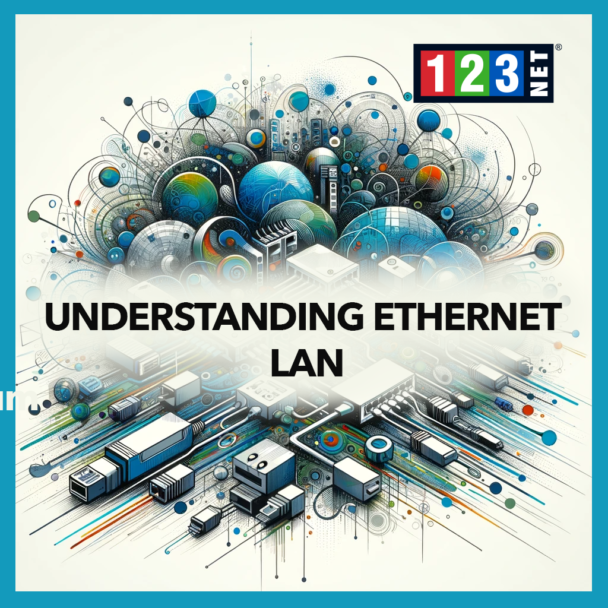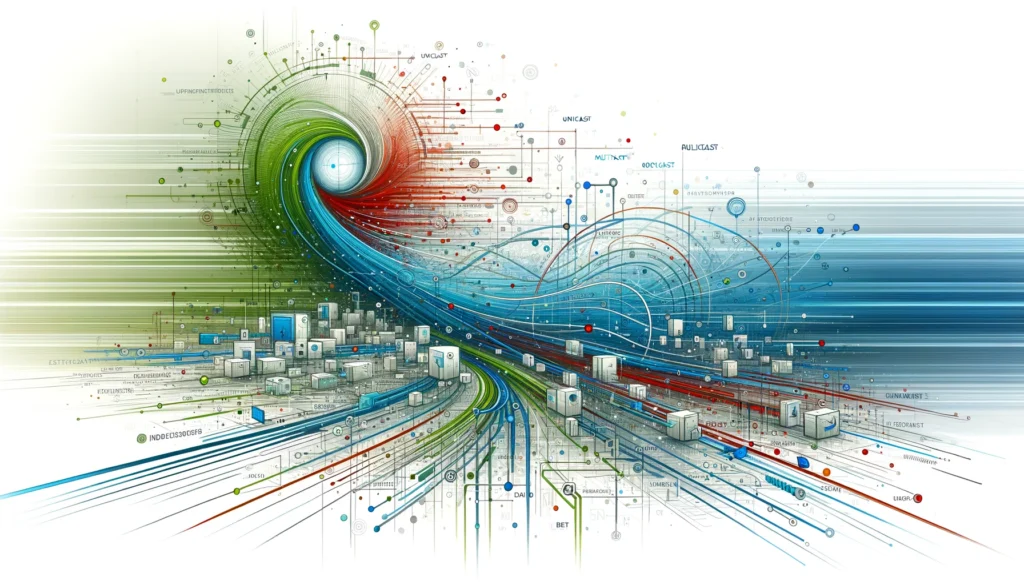
Introduction
Ethernet is a cornerstone technology in computer networking, essential for enabling communication within a local area network (LAN). Its widespread use across diverse sectors highlights its critical importance in facilitating swift and efficient data transfer among various devices and platforms. The adaptability and robustness of Ethernet technology make it indispensable in the digital era, catering to ever-increasing demands for connectivity and speed. This introduction explores the fundamental role of Ethernet in networking and underscores its lasting significance in shaping the landscape of modern digital communication.
Historical Background of Ethernet LAN
The development of Ethernet technology marks a pivotal moment in networking history. Initially standardized by IEEE 802.3, Ethernet has evolved significantly, from its original form to Fast Ethernet and subsequently to Gigabit Ethernet. This evolution reflects continuous improvements in speed and efficiency, addressing the growing demands of network traffic and connectivity. The journey from a modest experimental concept to a global standard illustrates Ethernet’s adaptability and its critical role in the advancement of network technologies.
Basics of Ethernet LAN
An Ethernet LAN (Local Area Network) is a network structure that uses Ethernet technology to enable communication among connected devices. Ethernet LANs are based on a set of fundamental principles that dictate how data is transmitted and managed within the network, ensuring efficient connectivity and interaction between devices. At the heart of these networks are Ethernet standards and protocols which oversee the handling and delivery of data packets across the network infrastructure.
Understanding these principles is crucial for anyone looking to grasp how Ethernet operates within varied network environments. Key components such as Network Interface Cards (NICs), hubs, switches, and routers play integral roles in the functionality of Ethernet LANs. NICs facilitate the physical connection of a device to the network, while hubs, switches, and routers direct and manage the flow of data across the network, ensuring that information reaches its intended destination efficiently and without interference.
Ethernet LAN Standards and Framing
IEEE 802.3 Standards
The IEEE 802.3 standards are vital for the implementation and functioning of Ethernet technology. They set the operational parameters and ensure compatibility across different devices within Ethernet networks. By defining how signals and data are to be formatted and transmitted over Ethernet cables, these standards help maintain a uniform approach across various manufacturers and devices, ensuring a seamless networking experience.
Ethernet Frame Structure
At the core of Ethernet technology lies the Ethernet frame, the principal unit of data transmission. An Ethernet frame is meticulously structured and comprises several key components:
- Preamble: This section contains a unique pattern that helps devices recognize the start of a frame and synchronize their internal clocks for data reception.
- Addresses: Each frame carries source and destination MAC Addresses, which are crucial for directing the frame to the correct recipient and identifying the sender.
- Type/Length: This field indicates either the type of protocol data contained within the frame or the length of the data, depending on the context.
- Data & Pad: The payload or actual data being transmitted is contained here. Padding is added to ensure that the data field meets the minimum length requirements for transmission.
- Checksum: Officially known as the Frame Check Sequence (FCS), this component is used to detect any errors that might have occurred during the transmission of the frame.
Evolution and Distinctions in Framing
Ethernet has evolved over the years, adapting to the needs of increasing speeds and greater network efficiency. This evolution is evident in the distinctions between the original Ethernet II framing and IEEE 802.3 standards. Ethernet II was designed for simplicity and efficiency in small networks, directly indicating the type of protocol data in its Type field. In contrast, IEEE 802.3 incorporates more complex tagging and identification systems, such as the Length field, to accommodate a wider range of data types and longer network segments. This distinction highlights how Ethernet standards have specialized and evolved to meet the diverse and expanding requirements of modern network environments. These developments have enhanced Ethernet’s robustness and adaptability, ensuring its continued relevance in the world of networking.
Addressing in Ethernet Networks
Ethernet addressing is a fundamental component of network communication. It is ensuring that data packets are accurately routed to their intended destinations within a network. The structure of Ethernet addresses is designed to support efficient and precise data distribution. This is critical for the overall performance and reliability of network systems.
Types of Ethernet Addresses: Ethernet addresses include unicast and multicast types, each serving different purposes:
- Unicast Addresses: These are unique to each device on the network. It is ensuring that data packets sent to a unicast address are delivered to a specific single recipient.
- Multicast Addresses: These addresses allow for the transmission of a single data packet to multiple destinations. Packets sent to a multicast address are received by all devices within a predefined group. This is useful for efficient broadcasting, especially in multimedia transmissions or data streaming.
Assignment and Operational Implications: Understanding how these addresses are assigned is crucial for network setup and effective management. Ethernet addresses, also known as MAC addresses, are typically pre-assigned to network interface cards (NICs) by manufacturers and consist of a unique series of numbers and letters. This permanence in addressing helps prevent address conflicts and aids in network management and security.
Importance in Network Topology and Security: The role of Ethernet addressing extends beyond simple data routing. In network topology, these addresses help map the physical and logical arrangements of network devices, facilitating optimized data paths and efficient traffic management. Furthermore, in network security, proper management of Ethernet addresses can prevent unauthorized access and ensure secure communication across the network.
Data Transmission and Collision Handling
Collision detection is vital in Ethernet networks, especially where multiple devices communicate on the same network segment. This mechanism is crucial in managing data flow and ensuring network reliability and efficiency. The Carrier Sense Multiple Access with Collision Detection (CSMA/CD) protocol is central to this process. It is designed to minimize and manage collisions effectively.
Understanding CSMA/CD: CSMA/CD works by allowing each device on the network to check the line before sending data to ensure no other device is transmitting at the same time. If the line is clear, the device proceeds with sending the data. However, if two devices send data simultaneously, a collision occurs. When this happens, CSMA/CD detects the collision and halts transmissions. Each device then waits for a random period before attempting to resend the data, reducing the likelihood of recurring collisions.
Role of the Interpacket Gap: The Interpacket Gap (IPG) is another critical component in managing data flow within Ethernet networks. It acts as a brief buffering period between packet transmissions, allowing the network to clear before another packet is sent. This gap helps to prevent the overlap of outgoing data packets, further reducing the risk of collisions.
Impact on Network Integrity and Performance: Effective collision management, facilitated by CSMA/CD and the IPG, is essential for maintaining the integrity and performance of Ethernet networks. These mechanisms ensure that data transmissions are smooth and uninterrupted, which is especially important in high-traffic network environments. By efficiently handling collisions, Ethernet networks can deliver data reliably and maintain high performance, even under significant load.
Advanced Ethernet Technologies
Technological advancements have significantly enhanced the functionality and application of Ethernet technology. It has particularly with the introduction of Switched Ethernet and Power over Ethernet (PoE). These innovations have expanded the versatility and efficiency of Ethernet networks across various environments.
Switched Ethernet: Switched Ethernet is a major advancement that has transformed network dynamics. Unlike traditional Ethernet setups where all devices share the same collision domain. Switched Ethernet allocates a unique collision domain to each device connected to a switch. This individual allocation significantly reduces the chances of collisions, thus enhancing the overall efficiency and throughput of the network. By minimizing collision domains, Switched Ethernet allows for smoother and faster communication between devices. Which is crucial in high-traffic network scenarios.
Power over Ethernet (PoE): PoE is another transformative technology that allows Ethernet cables to carry electrical power along with data. This dual functionality is particularly beneficial for powering devices like IP cameras, VoIP phones, and wireless access points. These are directly through the network cable, eliminating the need for separate power adapters. PoE simplifies the installation of networked devices in locations without easy access to electrical outlets and helps reduce cable clutter. It is thereby enhancing the scalability and flexibility of network installations.
Impact on Network Adaptability and Utility: These technological advancements not only improve the efficiency and functionality of Ethernet networks but also enhance their adaptability to diverse environments. Switched Ethernet and PoE enable more robust, flexible network architectures, facilitating easier deployment and management of connected devices. As a result, Ethernet’s utility is greatly expanded, proving its ongoing relevance and adaptability in the rapidly evolving landscape of network technology.
Ethernet LAN Configurations
Configuring an Ethernet LAN is a critical task that involves careful planning and setup to ensure optimal performance and connectivity. This process encompasses several key steps, from the initial network design to the selection of appropriate hardware and the resolution of common network issues.
Network Planning: Effective network planning is foundational to a successful Ethernet LAN setup. This stage involves mapping out the network layout, determining the number of devices, and understanding the bandwidth requirements. Planning helps in identifying the most efficient paths for data transmission and in choosing the best locations for network equipment.
Selecting Cabling and Devices: Choosing the right cabling and network devices (hubs, switches, routers) is crucial. The type of cable (e.g., Cat5e, Cat6) affects the network’s speed and distance capabilities. Similarly, selecting the appropriate devices—whether hubs for basic setups or switches and routers for more complex networks—affects performance and scalability of Ethernet LAN.
Troubleshooting Common Network Issues: Once the network is operational, monitoring and troubleshooting become ongoing tasks. Common issues might include cable faults, IP conflicts, or performance bottlenecks. Effective troubleshooting ensures the network operates smoothly and reliably.
Emphasizing LAN Configuration and Network Security: Proper LAN configuration and robust network security are paramount. Setting up network security measures such as firewalls, and ensuring proper device configurations, helps protect against unauthorized access and data breaches.
Conclusion
Ethernet LANs are the backbone of modern networking, offering reliability, speed, and flexibility. This article has explored the critical aspects of Ethernet technology. From its historical evolution to advanced applications in today’s digital landscape. Understanding and implementing Ethernet standards and practices is essential for maintaining robust and secure networks. It is demonstrating the enduring significance of Ethernet in the age of wireless and cloud computing.





